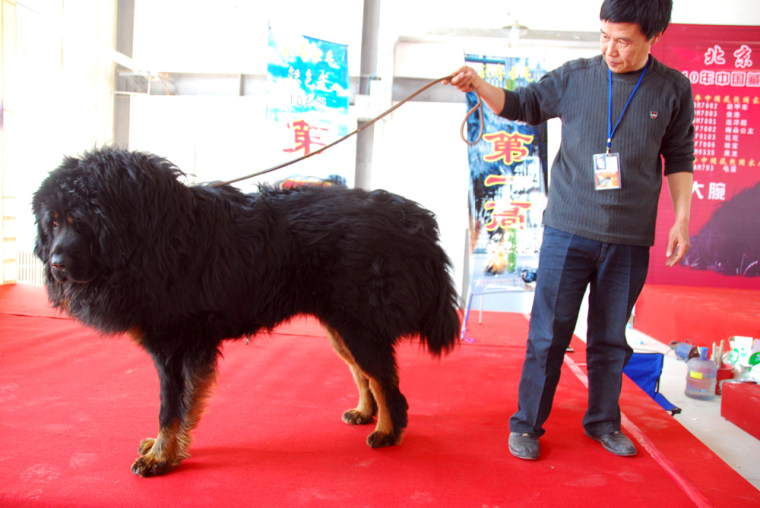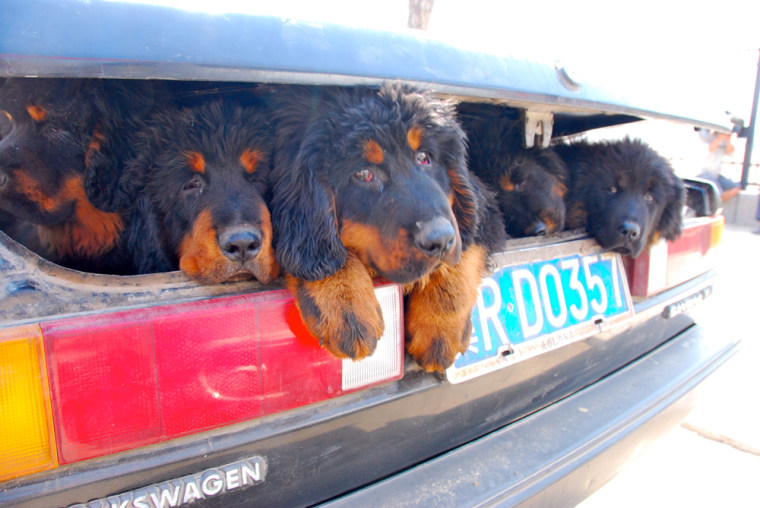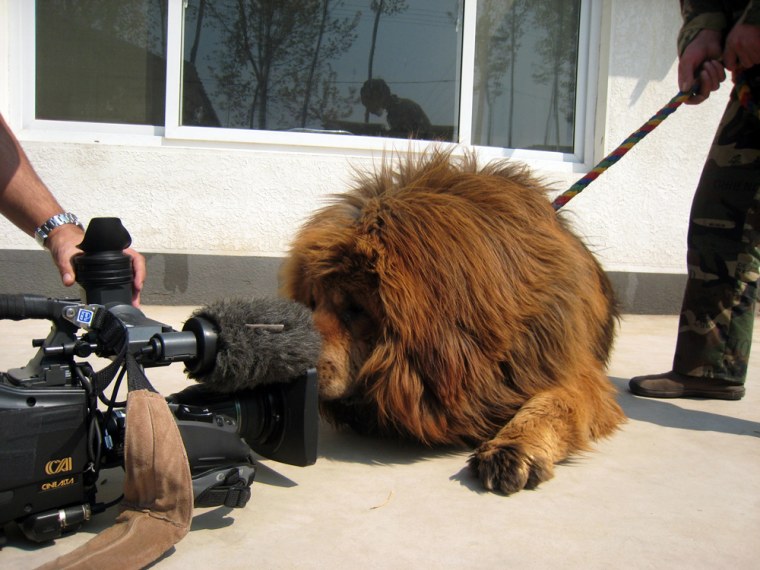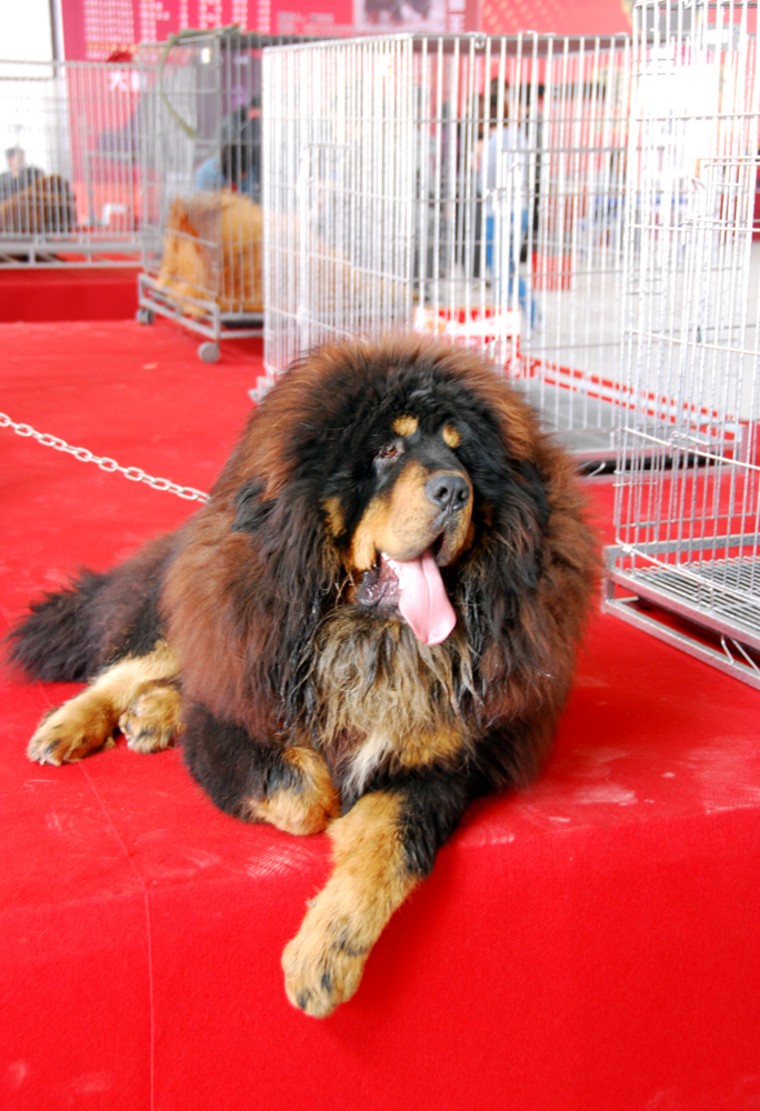The rattling steel-link chain was starting to freak us out. At each rattle, we glanced nervously over to where the sound was coming from.
The source? A giant Tibetan mastiff, standing at least 3 feet tall and weighing somewhere between 130 and 150 pounds. Inexplicably, he was chained on a platform right at the entrance of the Tianjin dog fair, guaranteeing a rude welcome for every individual wandering into the event in this large city in northeastern China.
There was no missing this dog. And if he didn’t bark the fear of God into you, there was a heavily made-up woman in heels and a miniskirt firmly steering you away: “Be careful. He’s a little temperamental.”
When his chain wasn’t anchored to a steel cage, it was held by a guy reclined on a folding chair. Somehow, only his arm, not his entire body, jerked up whenever the mastiff jumped up to bark at a new entrant.

We started looking around for something safe to climb on. But everywhere around us were mastiffs: some just as large, although none appeared as temperamental. Most, in fact, were puppies. All were available for sale or for breeding.
‘A holy animal’
The stuff of legend, the Tibetan mastiff is considered the guardian dog of the former Himalayan kingdom of Tibet and reputed to be the original source of many large dog breeds today.
“In China, people think of the Tibetan mastiff as a holy animal … a blessing to their health and security,” said Wen Li, a spokesman for , a website about Tibetan mastiffs, who helps organize dog fairs like the one in Tianjin.
In recent years, as China’s middle class has expanded and dogs have become more popular household pets, the appeal of Tibetan mastiffs has grown exponentially — so much so that fairs just for this breed take place several times a week during the three-month show season (the dogs shed during the summer, so the best time for breeders to present them is in the spring.) And as their popularity has grown, so have prices for top breeds — 500 percent a year.
In China, breeders say that adult Tibetan mastiffs typically sell for tens of thousands of dollars, with some going for more than $100,000, according to the Associated Press.
The popularity is apparently driven by Chinese millionaires. “Most buyers are wealthy people, like entrepreneurs,” said Wen. “The newly rich want to show off their status by owning such a precious dog, which makes them feel really confident and powerful.”
In that case, Cai Li and his wife must be brimming with confidence. Last November, the couple from the provincial capital of Xi’an forked over $600,000 for a purebred Tibetan mastiff called Yangtze River Number Two, and organized a fleet of twenty Mercedes-Benzes to bring the slobbery black-haired beast home.
“I like Tibetan mastiffs, because they’re really loyal to owners and they’re ferocious,” said Cai, a fortysomething-year-old businessman who was coy about his source of income.
Yangtze River Number Two cost so much, according to Cai, because of his pure bloodline. With their overwhelming popularity and the high prices they fetch, it’s increasingly rare to find a purebred Tibetan mastiff. Breeders told us there were permanent scouts in places like Yushu, Qinghai (a western Chinese province on the Tibetan Plateau struck by a huge earthquake in April), looking for mastiffs to poach.
Just an accessory?
Actually, Cai seemed a little frightened of Yangtze River Number Two’s ferocity, whereas his wife, in a home video, appeared delighted with him, romping through grassy fields with the giant dog at her heels.

In fact, Yangtze River Number Two was kept in a large cage during our visit to the couple’s country residence in the hills a couple of hours outside of Xi’an. At least he was in good company; Cai owns at least 40 other mastiffs, each kept in a cage.
The fact the dogs are kept behind bars reinforces the criticism that the animals are just status symbols for millionaires looking to flaunt their wealth.
“[These people] will first tell you how much that dog is. It’s not how much they love the dog,” said Fan Xing, who runs the International Centre for Veterinary Services in Beijing and fiercely opposes the current obsession with mastiffs. “You don’t really feed the dog. You don’t really walk the dog. You don’t really even play with the dog. You don’t have any relationship with the dog. That is not a pet lover.”

But owners like Cai insist they do care. “It’s very expensive to own a Tibetan mastiff. You have to love the dog to want to spend that kind of money,” Cai argued.
Breeders like Zhao Yanjun have no shortage of love for the dogs. “At the beginning I liked them, because I liked big dogs,” he told us. “Then I realized I could make a lot of money from them. And now I’m really in love with them.”
Zhao, whose kennel is in far northeastern Beijing, was a chicken farmer who made several thousand dollars when he began raising Tibetan mastiffs seven years ago. “I can easily make half a million U.S. dollars a year now,” he said. As if to underscore his point, there was a Porsche SUV behind him.
Altitude problemsBut for all the love and money being tossed around, Zhao and Cai admitted looking after the dogs is no cakewalk. “It’s not easy to keep Tibetan mastiffs,” said Cai. “Their diet, their health: All of that makes it difficult to raise them.”
The biggest challenge is helping the dogs adjust to sea level. Coming from the Tibetan Plateau, the breed is used to breathing thin air at altitudes of at least 12,000 feet.

When he first started buying Tibetan mastiffs and bringing them to Beijing, breeder Zhao Yanjun said his dogs would get very sick. “A few died,” he recalled. “But now things have changed. People pay more attention to vaccinations and take really good care of them.”
Zhao went to great lengths to explain the dogs’ appeal to owners. The most valued physical traits are the thickness of their fur and the shape of the mouth and jaw. In fact, one of Zhao’s prize-winning animals, named King, looked more like a lion than a dog. Another, named Bull, could do a great impersonation of a bear — if it could stand on its hind legs.
And then, of course, there’s their size: Some mastiffs can weigh up to 180 pounds. Lastly, in addition to their loyalty, Tibetan mastiffs are easy to train, explained Zhao.
“They can perform just as well as German shepherds.” Once they know their owner, he added, they are devoted to him forever. “But with strangers, they’re fierce.”
Which is exactly why, back at the Tianjin dog fair, we were relieved to end our shoot and beat a hasty retreat from the chain-rattling beast.